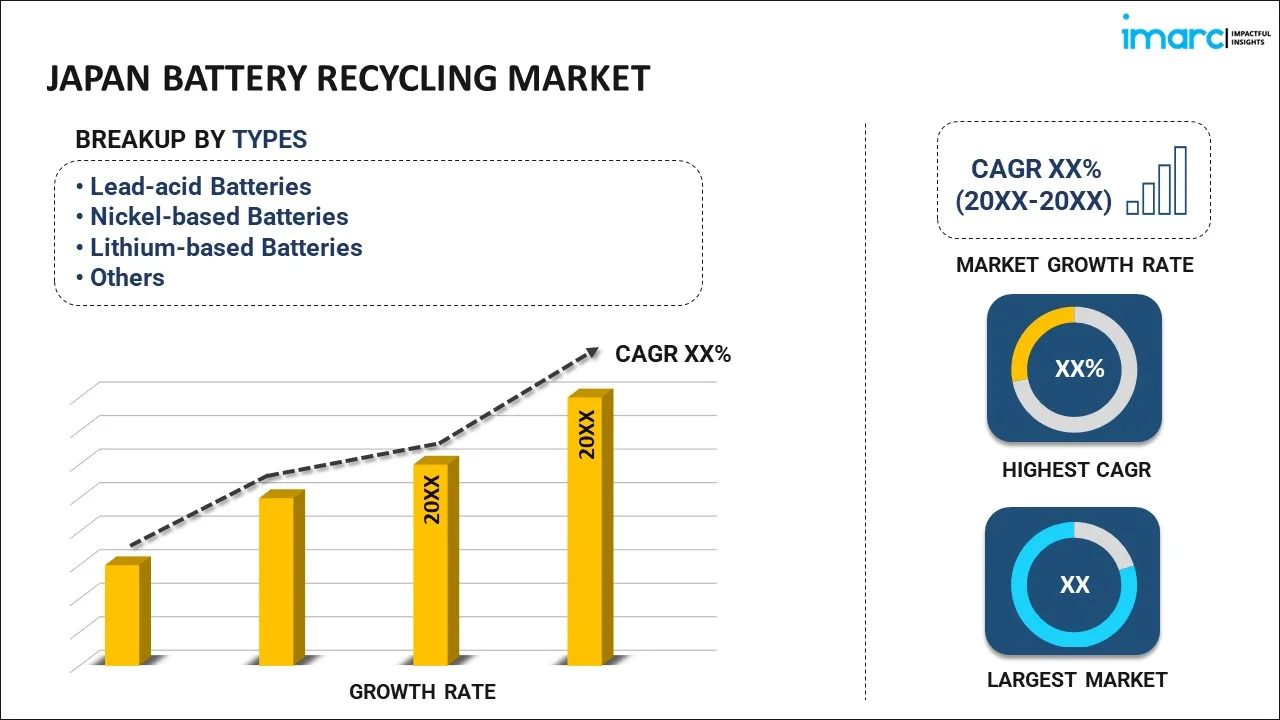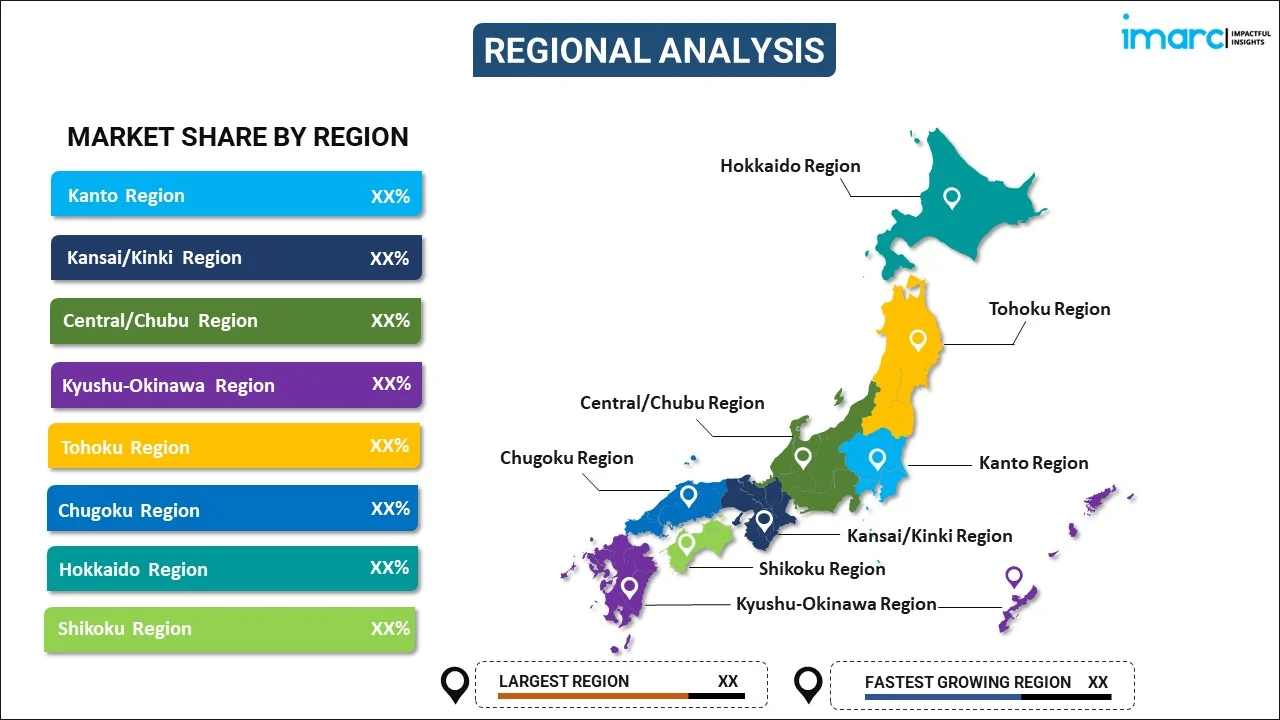
Japan Battery Recycling Market Report by Type (Lead-acid Batteries, Nickel-based Batteries, Lithium-based Batteries, and Others), Source (Industrial, Automotive, Consumer Products, Electronic Appliances, and Others), End Use (Reuse, Repackaging, Extraction, and Others), Material (Manganese, Iron, Lithium, Nickel, Cobalt, Lead, Aluminium, and Others), and Region 2025-2033
Market Overview:
Japan battery recycling market size reached USD 1,026.2 Million in 2024. Looking forward, IMARC Group expects the market to reach USD 2,663.6 Million by 2033, exhibiting a growth rate (CAGR) of 10.62% during 2025-2033. The market is being driven by the increasing popularity of electric vehicles (EVs) as a sustainable mode of transportation, a growing emphasis on environmental sustainability, and rising concerns regarding the scarcity of resources.
|
Report Attribute
|
Key Statistics
|
|---|---|
|
Base Year
|
2024 |
|
Forecast Years
|
2025-2033 |
|
Historical Years
|
2019-2024
|
| Market Size in 2024 | USD 1,026.2 Million |
| Market Forecast in 2033 | USD 2,663.6 Million |
| Market Growth Rate (2025-2033) | 10.62% |
Battery recycling involves the practice of repurposing materials found in used batteries, including metals, plastics, and electrolytes, with the aim of reducing environmental harm and preserving valuable resources. This typically involves a series of steps such as sorting, disassembling, and treating batteries to recover important metals like lithium, cobalt, and nickel. This process is vital in preventing the potential release of harmful substances into the environment. Given its significant role in promoting sustainability, waste reduction, and contributing to a circular economy by extending the useful life of valuable resources, the demand for battery recycling is on the rise.
Japan Battery Recycling Market Trends:
The Japan market primarily thrives due to the surging demand for hybrid and electric vehicles (EVs) on a wide scale. Correspondingly, the Japanese government, alongside various other nations, has made significant investments in EV manufacturing while implementing incentive programs to boost their widespread adoption. Additionally, strict governmental regulations concerning battery disposal, coupled with growing apprehensions surrounding battery waste management and a heightened emphasis on sustainable practices, are bolstering market growth. Furthermore, there is an increasing reliance on recycled batteries within Japan's consumer electronics sector. These batteries serve as integral components in the production of smartphones, power tools, laptops, gaming consoles, and remote-control units, which is acting as another significant growth-inducing factor. Besides this, the integration of robotics technology to enhance metal recovery rates stands as another pivotal driver of growth. Moreover, the limited availability of raw materials for lithium-ion battery production further encourages the recycling of discarded batteries. Additional factors influencing market growth encompass rapid industrialization, technological advancements in EV battery recycling, the introduction of visually appealing battery designs, and extensive research and development (R&D) initiatives undertaken by industry players to promote innovation in battery recycling practices. They are expected to fuel the regional market in the coming years.
Japan Battery Recycling Market Segmentation:
IMARC Group provides an analysis of the key trends in each segment of the market, along with forecasts at the country level for 2025-2033. Our report has categorized the market based on type, source, end use, and material.
Type Insights:

- Lead-acid Batteries
- Nickel-based Batteries
- Lithium-based Batteries
- Others
The report has provided a detailed breakup and analysis of the market based on the type. This includes lead-acid batteries, nickel-based batteries, lithium-based batteries, and others.
Source Insights:
- Industrial
- Automotive
- Consumer Products
- Electronic Appliances
- Others
A detailed breakup and analysis of the market based on the source have also been provided in the report. This includes industrial, automotive, consumer products, electronic appliances, and others.
End Use Insights:
- Reuse
- Repackaging
- Extraction
- Others
The report has provided a detailed breakup and analysis of the market based on the end use. This includes reuse, repackaging, extraction, and others.
Material Insights:
- Manganese
- Iron
- Lithium
- Nickel
- Cobalt
- Lead
- Aluminium
- Others
A detailed breakup and analysis of the market based on the material have also been provided in the report. This includes manganese, iron, lithium, nickel, cobalt, lead, aluminium, and others.
Regional Insights:

- Kanto Region
- Kansai/Kinki Region
- Central/ Chubu Region
- Kyushu-Okinawa Region
- Tohoku Region
- Chugoku Region
- Hokkaido Region
- Shikoku Region
The report has also provided a comprehensive analysis of all the major regional markets, which include Kanto Region, Kansai/Kinki Region, Central/ Chubu Region, Kyushu-Okinawa Region, Tohoku Region, Chugoku Region, Hokkaido Region, and Shikoku Region.
Competitive Landscape:
The market research report has also provided a comprehensive analysis of the competitive landscape. Competitive analysis such as market structure, key player positioning, top winning strategies, competitive dashboard, and company evaluation quadrant has been covered in the report. Also, detailed profiles of all major companies have been provided.
Japan Battery Recycling Market Report Coverage:
| Report Features | Details |
|---|---|
| Base Year of the Analysis | 2024 |
| Historical Period | 2019-2024 |
| Forecast Period | 2025-2033 |
| Units | Million USD |
| Scope of the Report | Exploration of Historical Trends and Market Outlook, Industry Catalysts and Challenges, Segment-Wise Historical and Future Market Assessment:
|
| Types Covered | Lead-acid Batteries, Nickel-based Batteries, Lithium-based Batteries, Others |
| Sources Covered | Industrial, Automotive, Consumer Products, Electronic Appliances, Others |
| End Uses Covered | Reuse, Repackaging, Extraction, Others |
| Materials Covered | Manganese, Iron, Lithium, Nickel, Cobalt, Lead, Aluminium, Others |
| Regions Covered | Kanto Region, Kansai/Kinki Region, Central/ Chubu Region, Kyushu-Okinawa Region, Tohoku Region, Chugoku Region, Hokkaido Region, Shikoku Region |
| Customization Scope | 10% Free Customization |
| Post-Sale Analyst Support | 10-12 Weeks |
| Delivery Format | PDF and Excel through Email (We can also provide the editable version of the report in PPT/Word format on special request) |
Key Questions Answered in This Report:
- How has the Japan battery recycling market performed so far and how will it perform in the coming years?
- What has been the impact of COVID-19 on the Japan battery recycling market?
- What is the breakup of the Japan battery recycling market on the basis of type?
- What is the breakup of the Japan battery recycling market on the basis of source?
- What is the breakup of the Japan battery recycling market on the basis of end use?
- What is the breakup of the Japan battery recycling market on the basis of material?
- What are the various stages in the value chain of the Japan battery recycling market?
- What are the key driving factors and challenges in the Japan battery recycling?
- What is the structure of the Japan battery recycling market and who are the key players?
- What is the degree of competition in the Japan battery recycling market?
Key Benefits for Stakeholders:
- IMARC’s industry report offers a comprehensive quantitative analysis of various market segments, historical and current market trends, market forecasts, and dynamics of the Japan battery recycling market from 2019-2033.
- The research report provides the latest information on the market drivers, challenges, and opportunities in the Japan battery recycling market.
- Porter's five forces analysis assist stakeholders in assessing the impact of new entrants, competitive rivalry, supplier power, buyer power, and the threat of substitution. It helps stakeholders to analyze the level of competition within the Japan battery recycling industry and its attractiveness.
- Competitive landscape allows stakeholders to understand their competitive environment and provides an insight into the current positions of key players in the market.
Need more help?
- Speak to our experienced analysts for insights on the current market scenarios.
- Include additional segments and countries to customize the report as per your requirement.
- Gain an unparalleled competitive advantage in your domain by understanding how to utilize the report and positively impacting your operations and revenue.
- For further assistance, please connect with our analysts.
 Inquire Before Buying
Inquire Before Buying
 Speak to an Analyst
Speak to an Analyst
 Request Brochure
Request Brochure
 Request Customization
Request Customization




.webp)




.webp)












